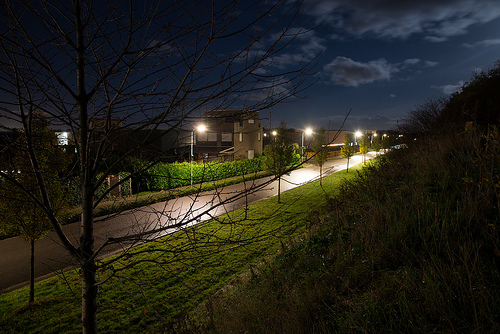A city may spend up to 50% of its electricity costs on keeping streetlights on, even when there is no one on the road. The result? Bright streets… and an immense waste of energy and funds that would likely be better used elsewhere. Enter the Tvilight zone: a Dutch company’s sensing streetlight system, known as Tvilight, that pick up on someone (or something) in the street, and instantly brighten the road in that particular area.

The Tvilight streetlight system will only light up when needed, leading to huge efficiency gains. Best of all, it’s smart enough to tell a squirrel from a pedestrian from a car. From Tvilight.
Using Tvilight, a road’s streetlights remain on, but are dimmed to 30% in order conserve energy. (The roads are never completely darkened, but, by keeping the lights dimmed to 30%, or a pre-set level determined by the city using the system, energy use can be reduced by 50 to 60%.) When a car, bike, or pedestrian approaches, the relevant lights illuminate the path. Unlike the motion-sensing lights some offices employ, the Tvilight system uses multiple lights to illuminate the area “all around a moving vehicle or pedestrian.”
Plus, the system’s sensors are intelligent enough to distinguish a bird from a tree branch, and brighten accordingly. As Fast Company reports, “The system can even tell what type of object is approaching; since a car moves faster, the lights around it are a bigger diameter and start brightening farther down the block.” The company plans to soon customize the system for traffic situations, such as turning streetlights red to warn drivers when a fire truck is approaching.
Explains the company, “The system consists of dimmable street lights (LED lighting) and a wireless sensor module which enables presence based light control. During off-peak hours lights dim to a pre-defined level.”
Tvilight’s wirelessly networked lights communicate with each other, ramping up illumination as vehicles and people pass instead of just switching on or off. All images from Tvilight.
Tvilight conserves energy, reduces maintenance costs and lowers CO2 emissions — specifically, up to 80% energy savings and up to 50% in reduced maintenance costs. That’s a significant impact, considering that, in Europe alone, the energy required to keep the continent’s 91 million streetlights running produces more than 40 million tons of CO2 emissions yearly.
Currently, the system, which was debuted in 2011, can be found installed in hundreds of locations, including areas in the Netherlands such as Assen (watch it in action here); Nuenen, a village; Groningen, where it is being used in an open parking lot; and certain train stations throughout the country. It is also being used in locations throughout Ireland, Germany, Australia, and Korea.
Filiz Zorluer of Tvilight’s communications department answers some questions about how it works:
Is there demand for the Tvilight system in the U.S.? Where is demand highest?
Yes, we do have demand from the U.S. Mostly from Los Angeles, which wants to transform into the greenest city in America. Our solution can play a key role in this.
In addition to lower energy and maintenance costs and CO2 emissions, what are some other practical benefits?
Light pollution is definitely one of the most important benefits of our solution. Last November we received from the International Dark-Sky Association a ”Dark Sky Defender Award,” which we are very proud of. Furthermore, our adaptive lighting controls can differentiate the road user — whether it is a car, cyclist, or pedestrian — and can filter out animals such as cats, dogs, birds, etc. We can also monitor the amount of traffic on the road, which can be used for better infrastructure planning in cities.
What was the original inspiration for this system?
Chintan Shah (Tvilight’s CEO) was inspired to design the lights while working at another job that required frequent travel. When he was flying, he was amazed to see how many streetlights were burning, even when there was no one around. With a little research, he found out that Europe pays over €10 billion each year to power streetlights. This is a huge waste of energy. He thought, ‘Why do we need to keep the lights burning all night at full strength?’
Where do you envision the Tvilight system being used?
Since our solution can be applied to both conventional and LED streetlights that are dimmable, these market segments are more interesting:
- Open parking spaces
- Small towns and villages
- Residential areas
- Secondary roads
- Ports / refineries
- University campuses
- Commercial zones (Walmart, Ikea,etc)
- Airport parking spaces
- Bicycle paths and more